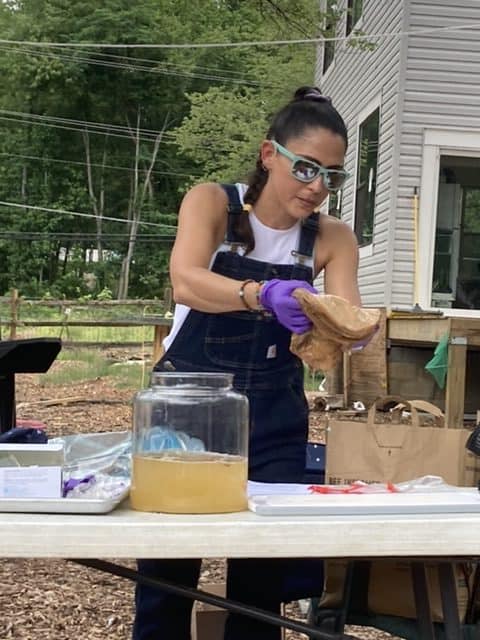Brewing ‘Bucha
A lesson in the fun of fermenting
By Kimberly Kweder
A covered container sat on a table at Wild Kid Acres. Inside, a jelly-like organism floated. One would almost wonder if it came from the depths of the Chesapeake Bay. It certainly wowed those on hand.
In reality, the mystery substance was a SCOBY—short for symbiotic colony of bacteria and yeast. The squishy, rubbery substance grew for eight years in a container on Carla Bowling’s kitchen counter in California and made the journey to Maryland with Bowling when she recently moved to a new home in Selby-on-the-Bay.
The well-traveled SCOBY is being used to start new batches of kombucha, and Bowling is the instructor of a homebrewing class at Wild Kid Acres Farm in Edgewater. (You may have spotted their goat in the Annapolis 4th of July parade this year). Wild Kid Acres opened last year, providing fitness classes, therapy, agricultural and environmental education, and event venues, says owner Gerardo Martinez.
“This piece of SCOBY is the main star,” said Bowling, as she snipped the layers and sectioned them into small bags for guests to take home. “It’s kind of like taking home a goldfish from the county fair,” added Bowling.
Bowling led 20 participants in step-by-step instruction to create their own kombucha, starting with caring for the SCOBY, brewing teas and mixing fruit flavors for the fizzy beverage.
Kombucha is a fermented drink made with tea, sugar, bacteria and yeast that has seen a surge in popularity recently. It’s thought to have originated in China or Japan many centuries ago. People who love this fermented drink usually praise the benefits of the bacteria, believed to help with digestion and a variety of ailments.
“The texture is like an oyster!” exclaimed a participant when being gifted with a piece of the SCOBY.
“I’ve had health issues and much of it is centered around the gut. My health has improved from eating fermented foods,” said Eve, a Mayo resident. “It’s about feeding healthy bacteria with fermented foods,” she added. Before embracing kombucha, she said she used to spend $50 per bottle on medicines for her conditions.
The steps for making kombucha are simple: First, grow the SCOBY and let it develop its layers. Second, brew a mild-flavored tea and add sugar, and lastly combine the hot tea, cold water, and mix into the fermenting container and let it sit on a counter or cabinet covered for 5-7 days.
To take it up a notch, there’s a second layer that’s all about the flavor. A variety of dried fruits, fresh fruits, bars, or fresh-pressed juices can be added to the concoction. Home-brewers need a funnel or strainer to discard the fruit pieces, Bowling said. She says the hardest part of home brewing is finding the SCOBY; she bought her first SCOBY from a store in California. From there, it’s about balancing the right temperature for healthy cultivation and growth.
One participant said homebrewing is a fun at-home project and less expensive than store-bought kombucha which can cost between $3-$4 per 16-ounce bottle.
“It’s a bit cheaper to make it on your own,” said Erin Dom, 29, of Silver Spring, who started home brewing during the quarantine last year. “The ingredients to brew it are just tea and sugar,” she added.
Bowling said that’s why she first got interested, too. “When you’re buying it [kombucha] at the store, the glass is what you’re paying for,” she said.
Others said they simply like the fizzy experience. “You want to buy it for the bubbles and the tears running down your face,” said Mark Dudley, 33, of Silver Spring.


